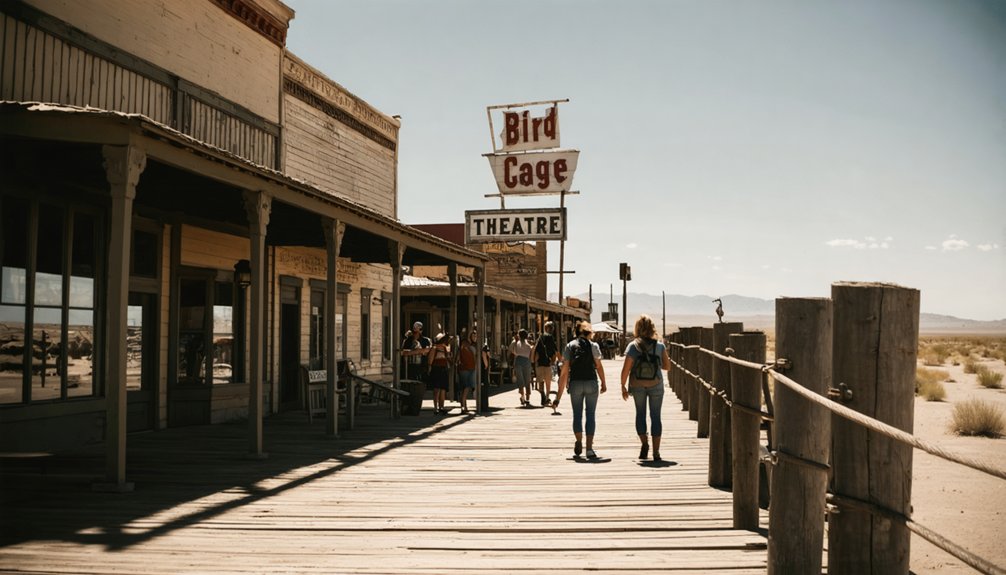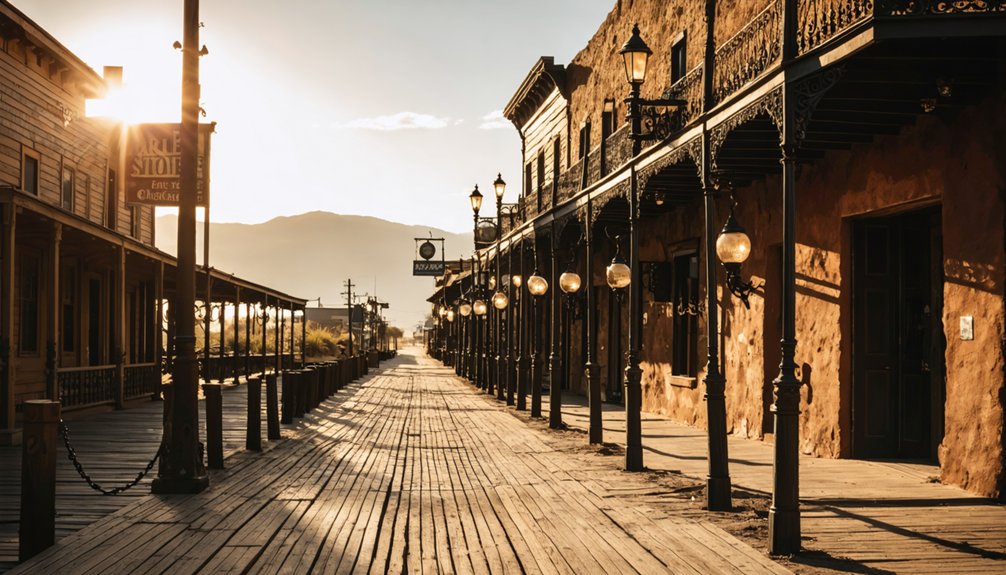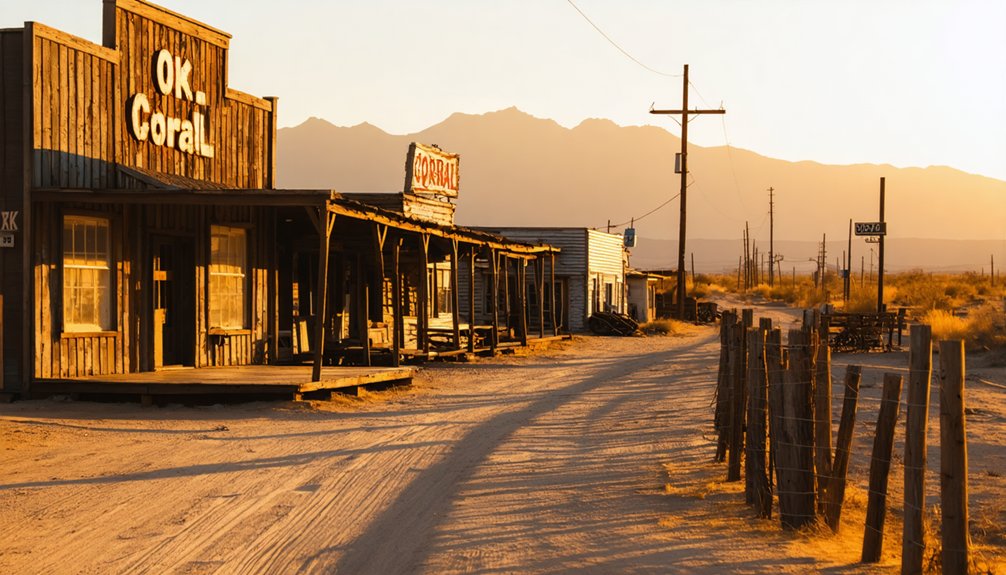Tombstone, Arizona isn’t a traditional ghost town, but a living historical site that survived its mining boom days. You’ll find the legendary O.K. Corral where the Earp brothers’ 30-second gunfight unfolded in 1881, and Boot Hill Graveyard housing 300 frontier souls. After silver mining declined in the early 1900s, the self-proclaimed “Town Too Tough to Die” reinvented itself through tourism, preserving its Wild West heritage for visitors to experience.
Key Takeaways
- Despite its “ghost town” nickname, Tombstone is an active community that preserved its Wild West heritage after the silver boom ended.
- Tombstone survived economic decline when silver mines flooded in the early 1900s, earning the nickname “The Town Too Tough to Die.”
- Tourism centered on the O.K. Corral gunfight and Boothill Graveyard transformed the former mining town into a historical attraction.
- The town maintains authentic 1880s buildings and offers daily gunfight reenactments that draw over 500,000 visitors annually.
- Preservation efforts converted the 1882 courthouse into a museum and secured national designations supporting Tombstone’s historical significance.
The Silver Strike That Built a Legend
When Ed Schieffelin traced silver flakes in the washes of Southern Arizona back to their source in 1877, he couldn’t have imagined he was uncovering the foundation of what would become one of the West’s most infamous towns.
His discovery revealed a vein 50 feet long and 12 inches wide, with ore worth $2,000 per ton—igniting the silver mining rush that transformed Goose Flats into Tombstone.
You can still see the remnants of this economic impact today.
The Contention lode, the richest in the district, helped produce 32 million troy ounces of silver, generating up to $37 million in wealth.
This fortune built a boomtown that swelled to 5,000 residents by 1882, attracting prospectors, businesspeople, and gunfighters alike—all seeking their fortune in Arizona’s most productive silver district.
Water issues became increasingly problematic as mines reached depths of 500 feet, with major companies spending hundreds of thousands on pumping operations.
Soldiers had jokingly warned Schieffelin he would find nothing but his tombstone in Apache territory, unknowingly predicting the name that would immortalize the town’s legacy.
From Dusty Outpost to Booming Western Hub
Within just four years, Tombstone transformed from a dusty outpost known as Goose Flats into one of the West’s most vibrant boomtowns, complete with a mapped layout, government structure, and booming economy.
Despite the tough landscape and harsh living conditions, pioneers like J.B. Allen built the first permanent structures in 1879, setting the stage for explosive growth.
The brave pioneers who tamed Tombstone’s unforgiving terrain laid foundations for Western prosperity beyond their wildest dreams.
You’d have witnessed:
- Population surging to nearly 12,000 by 1883
- Silver mines producing millions in precious metals
- Development of essential infrastructure including stage lines and railroads
- Diversification beyond mining into merchant and service economies
Mining challenges couldn’t dampen the town’s spirit—not even underground flooding that eventually crippled operations. The town was incorporated as a city and became the county seat of Cochise County on February 21, 1881.
This resilience earned Tombstone its reputation as “The Town Too Tough to Die,” drawing fortune seekers of all types who braved Apache threats and desert conditions for a shot at silver-lined prosperity. The town survived major setbacks including the Great Depression and two devastating fires that threatened to erase its frontier heritage.
The Day Gunfire Echoed at the O.K. Corral
Thirty seconds of gunfire on October 26, 1881, cemented Tombstone’s place in American frontier mythology forever.
As you walk Fremont Street today, you’re treading the ground where lawmen Wyatt, Virgil, and Morgan Earp, alongside Doc Holliday, confronted the Clanton and McLaury brothers in a clash that defined cowboy culture and Western justice.
The gunfight dynamics weren’t as straightforward as Hollywood portrays.
What began as an attempt to disarm the Cowboys—who allegedly violated Tombstone’s firearms ordinance—erupted into approximately 30 shots fired at point-blank range. The Earps carried their infamous Colt .45 Peacemakers during this legendary confrontation.
Three men died that day: Frank and Tom McLaury, and Billy Clanton.
Sheriff Johnny Behan’s testimony that the Cowboys attempted to surrender complicated the moral narrative, dividing public opinion between those viewing the Earps as peacekeepers and others seeing them as aggressors.
Despite its name in popular culture, the shootout actually occurred in a vacant lot on Fremont Street, not at the O.K. Corral itself.
Boot Hill: Final Rest for Frontier Souls
As you walk among the weathered markers at Boothill Graveyard, you’ll find the infamous graves of gunslingers like Billy Clanton and the McLaury brothers, who met their end during the O.K. Corral shootout.
Many frontier deaths recorded here occurred suddenly and violently, with victims buried quickly in simple wooden coffins or even just wrapped in blankets.
The cemetery’s stark epitaphs—some darkly humorous, others tragically brief—reveal how death on the frontier often came without ceremony, reflection of Tombstone’s harsh reality where one might be “buried with their boots on.”
Established in 1879 and active until 1884, the cemetery includes designated areas for Chinese citizens and a historically significant Jewish burial ground that remained largely forgotten for over a century.
The graveyard experienced a serious decline and ruin by the 1920s before local citizens undertook restoration efforts to preserve its historical significance.
Notorious Gunfighter Graves
While strolling through Boot Hill Graveyard, you’ll encounter the final resting place of Tombstone’s most notorious frontier figures—men who shaped the Wild West through gunfire and lawlessness.
The cemetery’s most infamous occupants include:
- Billy Clanton and the McLaury brothers (Tom and Frank), who fell during the legendary 30-second Gunfight at the O.K. Corral.
- Billy Claiborne, the self-proclaimed gunfighter who survived the Corral shootout only to die later in another duel.
- “Three Fingered Jack” Dunlop, shot down during an ill-fated robbery attempt.
- Marshal Fred White, accidentally killed by notorious outlaw Curly Bill Brocius.
You’re walking among men who died with their boots on—a phrase that gave this graveyard its name.
Many visitors report ghostly encounters here, with spectral shadows and unexplained phenomena surrounding these violent souls’ graves. Originally known as City Cemetery, this hallowed ground was established in 1878 during Tombstone’s explosive silver boom. The Boy Scouts helped restore the cemetery in the 1920s, locating burial sites of notable outlaws that visitors can see today.
Death Without Ceremony
Beyond the infamous gunslingers lies a broader story of Boothill Cemetery itself—a stark reminder of frontier mortality.
You’ll find approximately 300 souls buried here between 1879-1884, representing Tombstone’s diverse population. Death rituals were minimal—bodies were quickly interred, with few formalities marking their passing.
The cemetery’s layout reveals the social structure of frontier society, with separate sections for Chinese and Jewish residents. Many forgotten lives rest beneath simple stone markers—miners, housewives, and ordinary citizens who met their end through disease, accidents, or violence.
When you walk these grounds, you’re traversing a place where death came unexpectedly.
The cemetery’s name itself—adopted from Dodge City to attract tourists—reflects the reality that many died with their boots on, their stories abruptly ending on Tombstone’s unforgiving frontier.
Life and Death in America’s Wildest Town

You’d hardly recognize Tombstone’s boom-era streets where silver wealth fueled an endless parade of revelry across 110 saloons and numerous brothels, all while the town’s notorious “Cowboys” clashed violently with lawmen like the Earp brothers.
The infamous O.K. Corral gunfight of 1881 epitomizes this deadly tension, a 30-second shootout that’s come to symbolize the entire Wild West era and Tombstone’s legacy of frontier justice.
Boot Hill Cemetery tells the grimmest tales of this era through its markers—where murderers, murder victims, and those who simply “died with their boots on” rest side by side, a permanent record of how thin the line between life and death remained in America’s wildest silver boomtown.
Silver Fueled Revelry
As silver gushed from Tombstone’s rich veins between 1877 and 1881, a culture of extravagant revelry emerged that would define the town’s notorious reputation for generations.
You’d witness a boomtown transformed from a tent settlement to a metropolis of 14,000 souls, all chasing fortune in the desert.
The silver mining boom created unprecedented wealth, with miners extracting ore valued at $22,000 per ton, fueling a celebration of excess:
- Saloons and gambling halls operated 24/7, catering to 6,000 miners flush with silver earnings
- Monthly mine dividends of $50,000 circulated through town, funding endless entertainment
- Rapid wealth acquisition created a culture of spending rather than saving
- The town’s resilience after devastating fires reflected its “too tough to die” spirit
Boot Hill’s Grim Tales
Boot Hill Cemetery stands as Tombstone’s most haunting landmark, where the violent realities of frontier justice carved permanent stories into Arizona’s desert soil.
You’ll walk among graves of those who died with their boots on—a name coined in 1929 during the first Helldorado Days to attract tourists. Before this marketing stroke, locals simply called it “City Cemetery.”
The burial rituals reflected Tombstone’s diversity, with separate sections for Chinese and Jewish residents. By 1883, the main section was full, housing approximately 300 souls—40% dying from causes other than old age.
After decades of neglect, 1930s restoration efforts revealed the cemetery’s true scope. Today, you might sense ghostly encounters as you pass markers of gunslingers, miners, and madams—all testimonies to the harsh realities of frontier life.
Lawmen Versus Cowboys
While Boot Hill Cemetery preserved the final chapter of Tombstone’s deadliest conflicts, the streets themselves bore witness to the savage power struggle that defined Arizona’s most notorious boomtown.
The clash between Earp lawmen tactics and cowboy retaliation created a powder keg of tension that eventually exploded.
The confrontation escalated through:
- City ordinances banning public weapons carrying, deliberately targeting the Cowboys’ rural independence
- Sheriff Johnny Behan’s political protection of Cowboy interests, undermining Earp authority
- The 30-second O.K. Corral shootout that left three Cowboys dead but failed to end the conflict
- Morgan Earp’s assassination and Virgil’s maiming, triggering Wyatt’s vengeful “Vendetta Ride”
You’re witnessing the deadly dance between frontier freedom and encroaching civilization—a battle where neither side truly won, but Tombstone’s reputation was forever sealed.
How Tombstone Survived When the Silver Ran Out

When silver production became increasingly unprofitable in the early 1900s, Tombstone faced an existential crisis that would have destroyed most mining towns. The massive cost of pumping millions of gallons of underground water daily became untenable as silver prices plummeted and the U.S. abandoned the silver standard.
You’ll find Tombstone’s survival hinged on economic diversification—shifting toward other minerals like copper, gold, and manganese when possible.
More importantly, the town leveraged its Wild West heritage, particularly the famous 1881 OK Corral shootout. Tourism growth transformed former mining operations like the Goodenough Mine into popular attractions.
The town embraced its nickname “The Town Too Tough to Die,” creating a thriving service economy based on its frontier history that sustains Tombstone to this day.
The Town Too Tough to Die: Preservation Efforts
Despite facing near extinction after the silver industry collapsed, Tombstone has emerged as a model for historic preservation through decades of dedicated community efforts.
The town’s revival hinges on a delicate balance between historical authenticity and tourist accessibility.
Preserving Tombstone’s soul requires walking the tightrope between historical truth and visitor-friendly experiences.
Four cornerstones of Tombstone’s preservation strategy include:
- The Tombstone Restoration Commission’s transformation of the 1882 courthouse into a museum
- The Helldorado Festival, drawing 500,000+ visitors annually through historically-informed reenactments
- National designations like “Preserve America Community” that secure federal support
- Community engagement through locally-funded initiatives like the Fremont Street Revitalization Project
You’ll find preservation extending beyond buildings to cultural heritage sites like Boothill Graveyard, where original marked graves connect visitors to the authentic Wild West that defined Tombstone’s legendary status.
Walking Through History: Tombstone Today

As you step onto the weathered wooden boardwalks of Allen Street today, Tombstone’s rich historical tapestry unfolds before your eyes in a meticulously preserved tableau of America’s Wild West.
You’ll witness historic reenactments at the O.K. Corral, where professional actors bring the infamous 1881 shootout to life three times daily.
The town invites you to explore its haunted past through nightly walking tours where ghostly encounters are recounted at the notorious Bird Cage Theatre—site of 26 murders—and Boothill Cemetery, final resting place of outlaws and cowboys alike.
Costumed interpreters populate the saloons and streets, while stagecoach rides offer narrated journeys through the historic district.
Museums like the Tombstone Courthouse State Historic Park house authentic artifacts that connect you directly to the frontier town’s legendary past.
Frequently Asked Questions
Did Apache Attacks Actually Occur Within Tombstone City Limits?
Like shadows that never touched the silver city, Apache encounters in Tombstone’s limits aren’t supported by historical evidence. You’ll find they preferred raids on isolated targets, not fortified settlements.
What Happened to the Earp Brothers After Leaving Tombstone?
After Tombstone, you’d find the Earps scattered across the West. Wyatt and Josie fled to Colorado, Virgil recuperated in California, while their Earp legacy continued through gambling ventures and mining investments following their Earp conflicts.
How Did Women Influence Tombstone’s Development and Culture?
You’ve stumbled upon one of history’s overlooked forces—women’s roles in Tombstone transcended expectations through business ownership, community organization, and cultural contributions that fundamentally shaped the town’s development beyond its male-dominated mythology.
Were There Any Notable Chinese Residents in Tombstone?
Yes, China Mary stands out as Tombstone’s most influential Chinese resident. You’ll appreciate how she shaped Chinese contributions through her businesses and facilitated cultural exchanges as Hoptown’s unofficial leader and labor contractor.
What Role Did Mexican Citizens Play in Early Tombstone?
You’ll find Mexican citizens were integral to Tombstone’s early development, providing essential Mexican labor in mining and ranching while making significant cultural contributions that shaped the multicultural frontier community’s identity.
References
- https://themaritimeexplorer.ca/2025/01/29/tombstone/
- https://tombstonegunfights.com/history/
- https://discovertombstone.com/history/
- https://www.youtube.com/watch?v=bd5ypQs1nws
- https://www.achp.gov/preserve-america/community/tombstone-arizona
- https://www.arizonahighways.com/ghost-town-trail
- https://en.wikipedia.org/wiki/Tombstone
- https://en.wikipedia.org/wiki/Silver_mining_in_Arizona
- https://www.legendsofamerica.com/az-tombstonemines/
- https://tombstonechamber.com/about-tombstone-az/tombstone-history/



